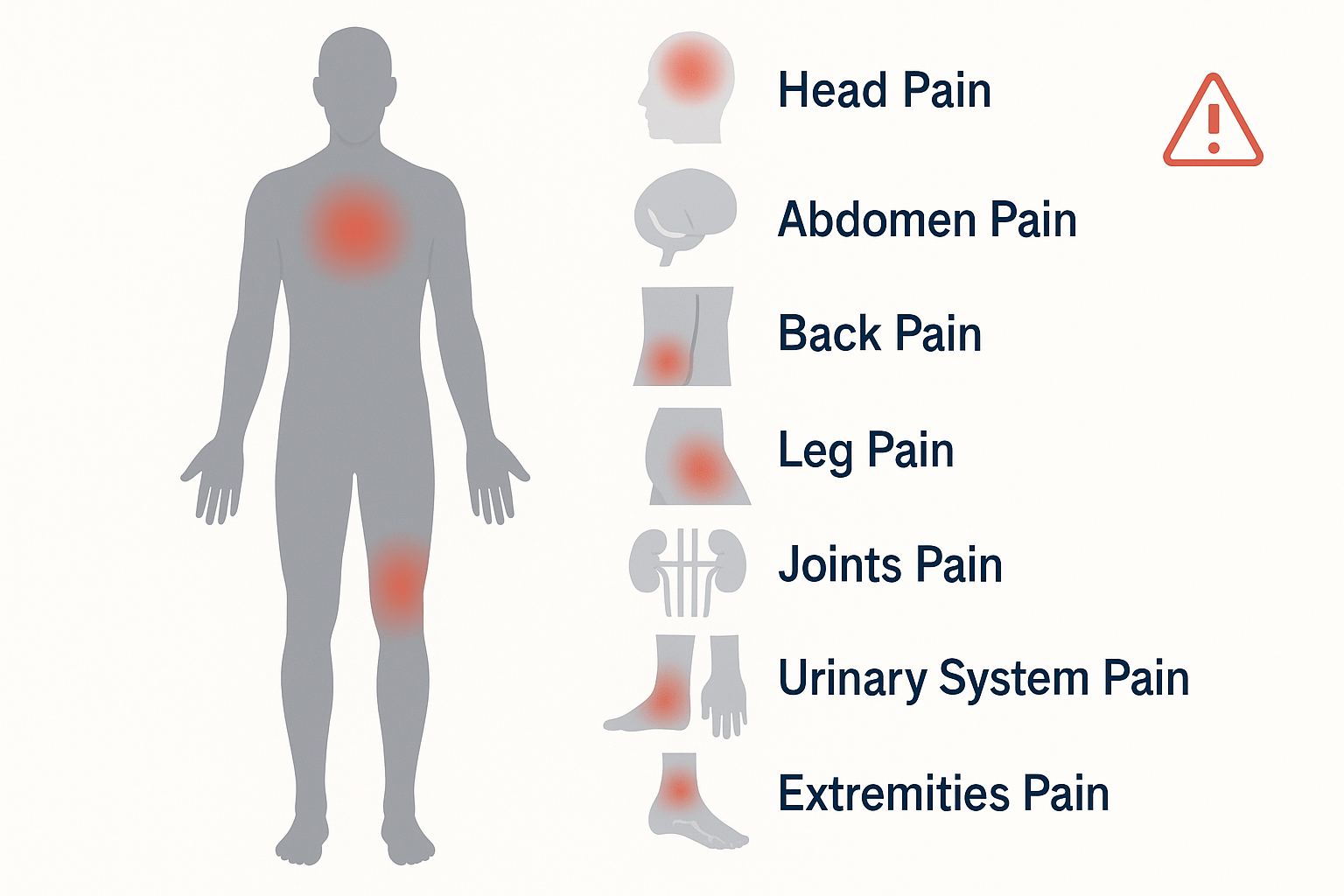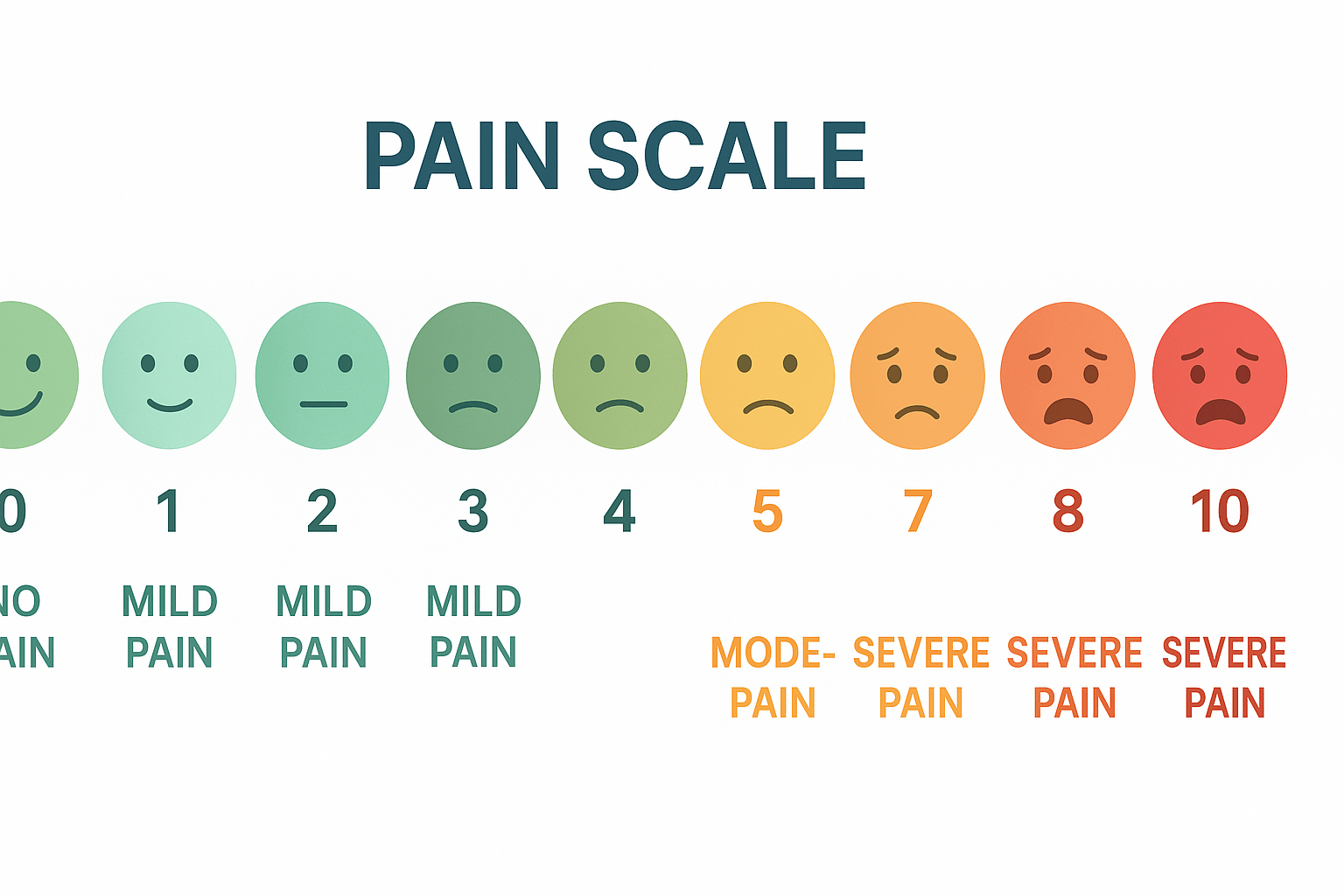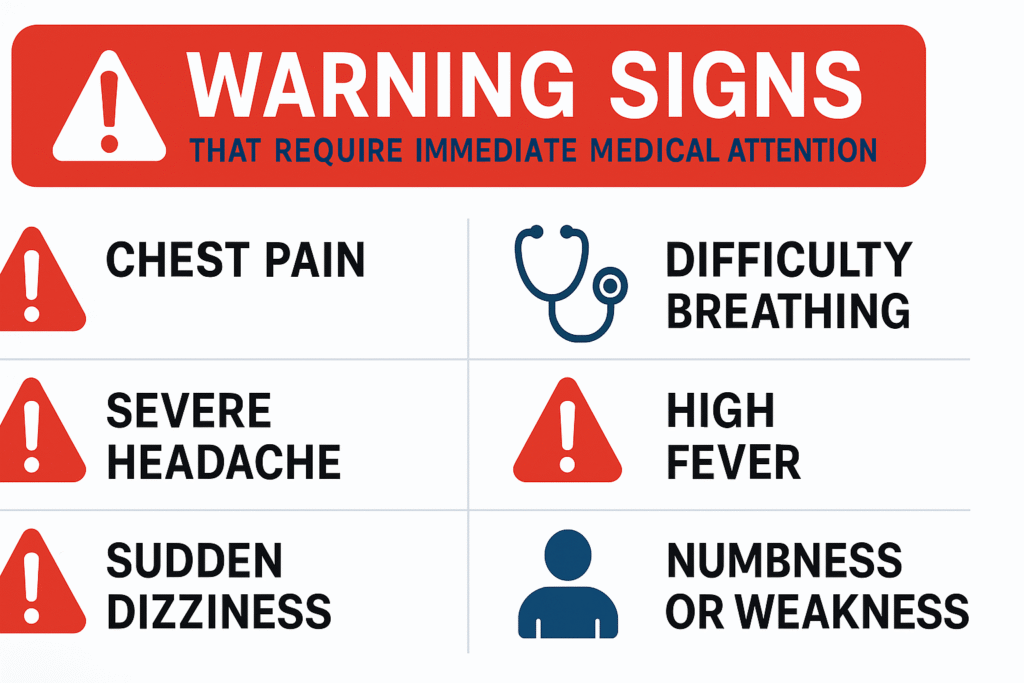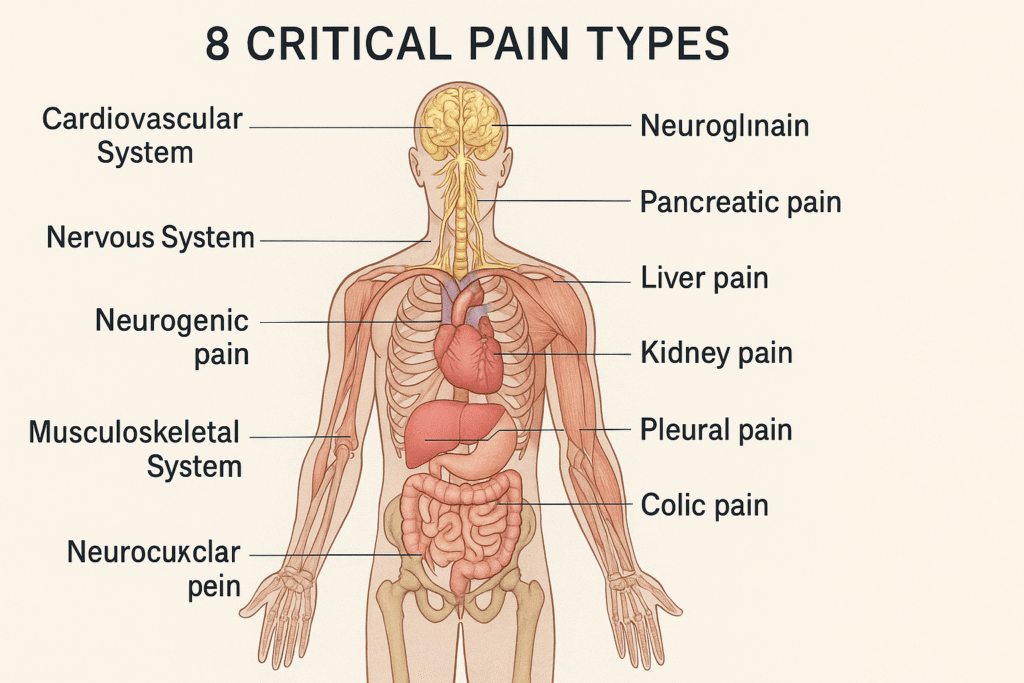Pain is your body’s alarm system, alerting you when something needs attention. While minor aches and discomfort are part of daily life, certain types of pain serve as critical warning signs that demand immediate medical care. Understanding the difference between normal discomfort and potentially serious symptoms could save your life.
This comprehensive guide explores eight types of aches and pains that should never be ignored, helping you recognize when to seek emergency care versus scheduling a routine appointment with your healthcare provider.
Understanding Pain: When Your Body Sends Warning Signals
Not all pain is created equal. Healthcare professionals distinguish between two primary categories:
Acute Pain: Sharp, sudden onset pain that serves as a protective mechanism, alerting you to potential injury or illness. This type of pain typically has an identifiable cause and requires immediate attention.
Chronic Pain: Persistent discomfort lasting longer than three months, often requiring specialized pain management approaches and ongoing medical supervision.
Red Flag Symptoms That Always Require Medical Attention
Before diving into specific pain types, recognize these universal warning signs that indicate serious medical conditions:
- Unexplained weight loss accompanying pain
- Weakness or numbness in extremities
- Loss of bowel or bladder control
- Pain accompanied by high fever or chills
- Sudden onset of severe pain unlike anything previously experienced
- Pain that progressively worsens despite rest and over-the-counter medications
8 Critical Aches and Pains You Must Never Ignore

1. Chest Pain: The Ultimate Medical Emergency
What It Could Mean: Chest pain represents one of the most serious warning signs your body can produce. While not all chest pain indicates a heart attack, the potential consequences of ignoring cardiac symptoms make this a medical emergency.
Serious Conditions Associated with Chest Pain:
- Heart attack (myocardial infarction)
- Angina (reduced blood flow to the heart)
- Pulmonary embolism (blood clot in the lungs)
- Aortic dissection (tear in the main artery)
- Pneumothorax (collapsed lung)
When to Seek Emergency Care:
- Crushing, squeezing, or pressure-like sensation in the chest
- Pain radiating to the left arm, jaw, neck, or back
- Chest pain accompanied by shortness of breath, nausea, or sweating
- Sudden onset of severe chest pain
- Any chest pain lasting longer than a few minutes
Important Note: Women may experience atypical heart attack symptoms, including fatigue, nausea, or upper back pain without classic chest pressure.
2. Severe Headaches: Recognizing Neurological Emergencies
What It Could Mean: While tension headaches and migraines are common, certain headache patterns signal serious neurological conditions requiring immediate intervention.
Serious Conditions Associated with Severe Headaches:
- Stroke or transient ischemic attack (TIA)
- Brain aneurysm rupture
- Meningitis or encephalitis
- Increased intracranial pressure
- Temporal arteritis
When to Seek Emergency Care:
- “Thunderclap” headache – sudden, severe pain described as “the worst headache of your life”
- Headache accompanied by fever, stiff neck, or rash
- Headache with confusion, vision changes, or difficulty speaking
- Headache following a head injury
- Progressive headaches that worsen over days or weeks
- New headache patterns in people over 50
3. Abdominal Pain: Identifying Internal Emergencies
What It Could Mean: Abdominal pain encompasses a wide range of potential conditions, from minor digestive issues to life-threatening emergencies requiring surgical intervention.
Serious Conditions Associated with Abdominal Pain:
- Appendicitis
- Gallbladder inflammation (cholecystitis)
- Pancreatitis
- Bowel obstruction
- Ruptured ovarian cyst
- Ectopic pregnancy
When to Seek Emergency Care:
- Severe, constant abdominal pain that prevents normal activities
- Pain accompanied by vomiting, fever, or inability to pass gas
- Abdominal pain with rigid, board-like stomach muscles
- Pain that worsens with movement or coughing
- Abdominal pain with signs of shock (rapid pulse, dizziness, cold sweats)
4. Back Pain with Neurological Symptoms
What It Could Mean: While common back pain affects millions, certain presentations indicate serious spinal or systemic conditions requiring urgent medical evaluation.
Serious Conditions Associated with Concerning Back Pain:
- Spinal cord compression
- Cauda equina syndrome
- Spinal infection (osteomyelitis)
- Kidney infection (pyelonephritis)
- Aortic aneurysm
When to Seek Emergency Care:
- Back pain with fever, especially if accompanied by chills
- Loss of bladder or bowel control
- Numbness or weakness in legs
- Back pain following significant trauma
- Progressive weakness in lower extremities
- Severe back pain that doesn’t improve with rest
5. Leg Pain: Detecting Blood Clots and Circulation Issues
What It Could Mean: Leg pain, particularly in the calf, can indicate serious vascular conditions that may lead to life-threatening complications if left untreated.
Serious Conditions Associated with Leg Pain:
- Deep vein thrombosis (DVT)
- Peripheral artery disease
- Compartment syndrome
- Cellulitis or deep tissue infection
When to Seek Emergency Care:
- Sudden onset of severe calf pain with swelling and warmth
- Leg pain accompanied by shortness of breath or chest pain
- Cold, pale, or blue-tinged extremity
- Severe leg pain following injury with suspected fracture
- Signs of infection: red streaking, fever, or rapidly spreading redness
6. Joint Pain with Systemic Symptoms
What It Could Mean: Joint pain combined with other symptoms may indicate serious inflammatory conditions, infections, or autoimmune disorders requiring prompt medical intervention.
Serious Conditions Associated with Joint Pain:
- Septic arthritis (joint infection)
- Rheumatoid arthritis flare
- Gout attack
- Lyme disease
- Systemic lupus erythematosus
When to Seek Medical Care:
- Joint pain with fever and inability to move the joint
- Rapid onset of severe joint swelling and redness
- Joint pain accompanied by rash or other systemic symptoms
- Multiple joints affected simultaneously
- Joint pain that significantly limits daily activities
7. Urinary Pain and Changes
What It Could Mean: Painful urination or changes in urinary patterns can indicate infections, kidney problems, or other urological conditions requiring medical treatment.
Serious Conditions Associated with Urinary Symptoms:
- Kidney infection (pyelonephritis)
- Kidney stones
- Urinary tract infection (UTI)
- Prostatitis in men
- Sexually transmitted infections
When to Seek Medical Care:
- Painful urination with fever, chills, or back pain
- Blood in urine
- Inability to urinate despite feeling the urge
- Severe pelvic or flank pain
- Urinary symptoms in men (less common, often more serious)
8. Hand and Foot Pain with Circulation Changes
What It Could Mean: Pain in extremities, especially when accompanied by color changes or numbness, may indicate circulation problems, nerve damage, or systemic conditions.
Serious Conditions Associated with Extremity Pain:
- Peripheral neuropathy
- Compartment syndrome
- Frostbite or severe cold injury
- Arterial occlusion
- Severe infection
When to Seek Medical Care:
- Sudden onset of severe pain with color changes (white, blue, or black)
- Loss of sensation or ability to move fingers or toes
- Signs of infection with red streaking
- Pain following significant trauma or crush injury
Pain Management Strategies and Communication

How to Communicate Pain Severity to Healthcare Providers
Effective communication about your pain helps healthcare providers make accurate diagnoses and treatment decisions. Use these strategies:
Pain Scale Description:
- 0: No pain
- 1-3: Mild pain that doesn’t interfere with activities
- 4-6: Moderate pain that interferes with some activities
- 7-9: Severe pain that significantly limits activities
- 10: Worst possible pain, unable to function
Additional Descriptive Terms:
- Sharp, stabbing, burning, aching, throbbing
- Constant vs. intermittent
- What makes it better or worse
- Associated symptoms
When to Use Emergency Services vs. Primary Care
Emergency Room Situations:
- Life-threatening symptoms
- Severe pain with concerning associated symptoms
- Inability to reach your primary care provider for urgent issues
- Pain following significant trauma
Primary Care Appointments:
- Chronic pain management
- Non-urgent pain evaluation
- Follow-up for ongoing conditions
- Preventive care discussions
Preventive Measures and Lifestyle Factors

Reducing Your Risk of Serious Pain Conditions
While not all serious conditions are preventable, certain lifestyle modifications can reduce your risk:
Cardiovascular Health:
- Regular exercise and healthy diet
- Blood pressure and cholesterol management
- Smoking cessation
- Stress management techniques
Musculoskeletal Health:
- Proper ergonomics and body mechanics
- Regular stretching and strengthening exercises
- Maintaining healthy weight
- Adequate sleep and recovery
General Health Maintenance:
- Regular medical check-ups and screenings
- Vaccination compliance
- Medication adherence for chronic conditions
- Staying hydrated and maintaining good nutrition
Pain Medication Safety and Alternatives
Safe Use of Over-the-Counter Pain Medications
When managing minor pain, follow these guidelines:
- Read and follow dosing instructions carefully
- Be aware of medication interactions
- Don’t exceed recommended daily limits
- Consult healthcare providers before combining medications
- Consider non-medication alternatives for chronic pain
Alternative Pain Management Approaches
- Physical therapy and rehabilitation
- Heat and cold therapy
- Massage and manual therapy
- Acupuncture and acupressure
- Mindfulness and relaxation techniques
- Cognitive behavioral therapy for chronic pain
Take Action: Your Health Depends on It

Pain serves as your body’s early warning system, and ignoring serious symptoms can have devastating consequences. Trust your instincts – if something feels seriously wrong, seek medical attention immediately. Healthcare providers would rather evaluate a false alarm than miss a critical diagnosis.
Remember that early intervention often leads to better outcomes, less invasive treatments, and improved quality of life. Don’t let fear, embarrassment, or cost concerns prevent you from seeking necessary medical care.
Key Takeaways:
- Learn to recognize red flag symptoms that require immediate attention
- Understand the difference between normal discomfort and serious warning signs
- Know when to use emergency services versus scheduling routine appointments
- Communicate effectively with healthcare providers about your pain
- Take preventive measures to reduce your risk of serious conditions
Frequently Asked Questions
Q: How do I know if my pain is serious enough for the emergency room?
A: Seek emergency care for sudden, severe pain; pain with concerning symptoms like fever, shortness of breath, or neurological changes; or any pain that feels dramatically different from your normal experience.
Q: Can stress cause serious physical pain?
A: While stress can cause real physical symptoms, don’t assume serious pain is “just stress.” Always have concerning symptoms evaluated by a healthcare provider to rule out serious conditions.
Q: Should I take pain medication before seeing a doctor?
A: For severe pain, taking medication as directed is generally acceptable, but inform your healthcare provider about what you’ve taken and when. Some medications may mask important diagnostic symptoms.
Q: How long should I wait before seeking medical care for persistent pain?
A: Don’t wait if you have red flag symptoms. For other persistent pain, contact your healthcare provider if symptoms don’t improve within a few days or if they progressively worsen.
Q: Are there any pain symptoms that are always emergencies?
A: Yes – chest pain with cardiac symptoms, sudden severe headache, signs of stroke, severe abdominal pain with vomiting, and any pain with loss of consciousness or severe difficulty breathing always warrant emergency care.
Your health is invaluable, and recognizing these critical warning signs could save your life or prevent serious complications. When in doubt, seek medical attention – it’s always better to be cautious when it comes to your health and well-being.



